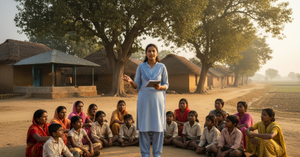“Mumma, I ate it already!” The Moment That Sparked a Thought
It was just a tiny, bright, and tempting candy. Before the mother could say a word, her 4-year-old had already swallowed it, partly wrapped in its transparent film. She checked quickly, no choking, no coughing, no tears. Just that mischievous grin. But later that night, the question lingered: Was that plastic wrapper inside his tummy right now? This situation, familiar in homes and classrooms everywhere, might seem too trivial to fuss over. After all, “kids do this all the time,” right? But pediatricians are urging parents to pause, not panic, but pay attention.
Because in that tiny moment of carelessness, toxic materials, microbes, and digestive hazards can sneak in silently.
The Forgotten Step: Why Children Skip Unwrapping Food
Children often overlook the need to unwrap food completely, and the reasons are both simple and significant:
- Excitement and Impatience: The desire to eat quickly can override caution.
- Lack of Awareness: Young children don’t always recognize plastic or foil as inedible.
- Soft Packaging Confusion: Some candies are wrapped in waxy paper or edible-looking films.
- Imitation: When adults or peers pop things into their mouths casually, kids mirror the behavior.
In a 2021 survey published in the Indian Journal of Child Health, nearly 1 in 4 parents admitted their child had once ingested food with part of the packaging still on, either accidentally or without knowing it wasn’t edible.
When the Wrapper Goes In What Actually Happens?
1. Physical Blockage and Discomfort
Soft plastic or foil doesn’t dissolve in the stomach. In younger children with smaller digestive tracts, this can cause:
- Abdominal pain
- Nausea or bloating
- Obstruction in rare cases
A clinical case published in the Journal of Pediatric Gastroenterology described a 3-year-old with chronic constipation caused by compacted bits of candy wrappers that had built up over time.
2. Toxicity from Materials
Not all wrappers are made the same. Ingesting even a small amount can introduce:
- Polyvinyl chloride (PVC): Found in some cheap wrappers and linked to hormone disruption
- BPA and Phthalates: Known endocrine disruptors that may interfere with development
- Inks and Dyes: Especially on printed papers, these may not be food-safe and can irritate the gut lining
Some packaging materials are safe around food, but not inside a body.
3. Chemical Migration into the Food Itself
Even when the wrapper isn’t eaten, improper packaging (especially when heated or stored too long) can cause chemicals to leach into the food. This is especially true with oily or acidic snacks.
A study in Food Additives & Contaminants showed that food wrapped in low-quality plastics often tested positive for residual solvents, plasticizers, and formaldehyde derivatives.
But It’s Just One Bite Right?
While an occasional, small ingestion may not always cause immediate harm, repeated habits or exposure to low-grade packaging used by unregulated brands can lead to:
- Low-level toxin buildup
- Gut inflammation
- Allergic reactions in sensitive children
- Pica-like behavior, where children begin to seek out non-food items
The Indian Academy of Pediatrics emphasizes that the early years are critical for building not only eating patterns but also detoxification capacity and organ resilience. It’s better to prevent exposure than to manage consequences later.
How to Build Better Habits Without Creating Fear
1. Use Routine as Your Ally
Turn unwrapping into a ritual. “Let’s peel it together!” makes it fun and mindful. Allow your child to do it themselves with supervision so they can build awareness.
2. Teach What’s Edible (and What’s Not)
Use mealtime to talk about what is safe to eat. Hold up wrappers and ask, “Can we eat this?” Let kids explore texture, color, and smell — engaging the senses is a learning tool.
3. Pack Smartly for School
Avoid individually wrapped snacks. Choose whole fruits, homemade treats, or items in simple containers. Not only is it safer, but it also reduces waste.
4. Watch Out for “Edible-Looking” Wrappers
Some brands use wax paper, transparent cellulose, or glossy plastic that can easily confuse a child. Stick to brands with clear unwrapping cues or buy from trusted sources.
5. Create a “Check Before You Eat” Rule
Just like washing hands before meals, unwrapping fully can be built into a daily routine. Posters, stickers, or storytelling can reinforce this in classrooms and at home.
Manufacturer Responsibility: It’s Time to Step Up
Food brands play a vital role in consumer safety. Especially when children are involved, manufacturers should:
- Avoid excessive or confusing packaging
- Use food-safe, clearly non-edible wrappers
- Include pictorial instructions for unwrapping
- Ensure print dyes and glues are non-toxic and approved for incidental contact
The Food Safety and Standards Authority of India (FSSAI) has issued guidelines for primary packaging materials, but implementation is still patchy, especially among local snack vendors and sweet shops.
Advocacy and consumer awareness will be key to driving safer practices across the food industry.
A Story to Share
A kindergarten teacher in Pune introduced a simple rule in her classroom: “No plastic comes to your tummy!” Within a week, her students were pointing out to each other, “Don’t eat that, it still has the cover!”
They weren’t scared. They were proud.
That’s the power of awareness when safety becomes second nature.
Conclusion: Safety First, Always
A wrapper may seem like a small detail, but for a child’s growing body, it matters. Improper unwrapping isn’t just about manners or mess; it’s about avoiding toxins, preventing digestive troubles, and teaching lifelong safety skills.
By making tiny changes, checking packaging, slowing down before eating, and involving kids in the process, we help ensure that each bite nourishes, not harms. Because when it comes to children’s health, no layer of protection is too small to matter.









Be the first one to comment on this story.